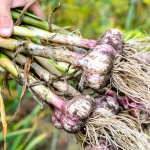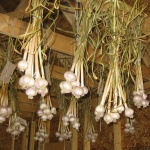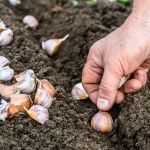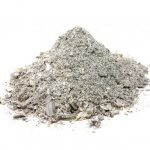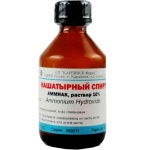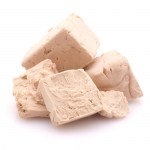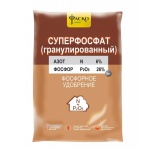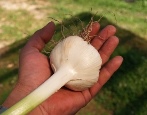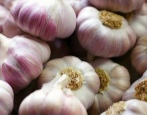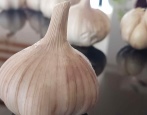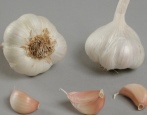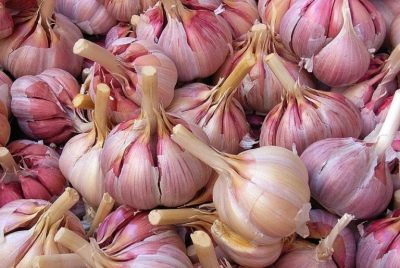
- Year of approval: 1978
- Sheet length, cm: up to 40
- Leaf color: green, slightly waxy coating
- The form: rounded flat
- Bulb size: large
- Bulb weight, g: 30
- Number of teeth: 7-11
- Dry scales: off-white with a purple tint
- Density: dense
- Taste: spicy
Garlic Komsomolets is well known to summer residents throughout Russia. The variety was bred back in 1978 by specialists of the Federal Scientific Center for Vegetable Growing, and is considered one of the best among winter varieties of culture. It is excellent for growing in most climates, has impressive head sizes, is cold-resistant and unpretentious.
Description of the variety
Winter variety, arrow, for universal use. Differs in very good keeping quality. Initially, the variety was focused on the black earth zones of agriculture, but it has proven itself well in other climatic conditions. The heads are distinguished by excellent marketability, they are aligned, neat, clean.
Characteristics of the appearance of plants and bulbs
The plant forms a stem about 100 cm high. The length of the leaves is about 40 cm, they are green, with a slight waxy bloom. The arrows are high, with an average number of air bulbs.
The shape of the heads is round-flat, the size is large, the weight reaches 30 g, but this indicator is influenced by the frequency of planting, the composition of the soil. The number of cloves in a bulb varies from 7 to 11 pieces. Dry scales are painted in an off-white tone with a purple tint, the number of layers is 4-6. The pulp is juicy and firm, dense. The juicy scales are purple or brownish-purple.
Purpose and taste
The variety is intended for fresh consumption, as well as for all types of processing. The taste of leaves and cloves is sharp, bright, spicy.
Maturation
Komsomolets is a mid-season garlic. From germination to yellowing and lodging of leaves, it takes about 120 days.
Yield
High-yielding variety. On average, it gives 1.35 kg of garlic from 1 m2.
Growing regions
The variety is acclimatized for cultivation in the Central Black Earth Region, in the northern and northwestern regions, in Siberia and the North Caucasus. The possibilities for its planting are practically unlimited by regional factors.
Landing dates
The optimal period for embedding in the ground for this winter variety is mid or early October. During this period, the cloves are planted in order to get early shoots in the spring.
Growing and care
It is best to plan the planting of this garlic in an open area with good lighting for most of the day. In the shade, Komsomolets noticeably decreases its productivity. The largest teeth are selected for planting, pre-treated with a solution of manganese or copper sulfate. I arrange them according to the scheme 10x35 or 10x45 cm with a depth of 70 mm.
When planting in winter, a bed of Komsomolets garlic is mulched abundantly with fresh sawdust or agromaterial, this protective layer is removed in spring. With the emergence of seedlings, weekly watering is carried out in the grooves between the rows, it can be completely stopped no earlier than 3-4 weeks before harvesting. Arrows appearing on plants break off so that the main nutrition is directed to the formation of large heads. It will be useful to feed the plants with ammophos 2-3 times per season.

You can plant garlic twice a year. The spring species is best planted in the spring, the winter one is sown before winter. Planting time depends on the region, climatic conditions, varieties, favorable days. It is also necessary to properly prepare planting material and beds.
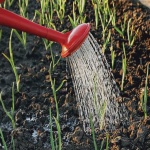
Soil requirements
The main recommendations for the choice of soil relate to the level of acidity. For Komsomolets, soil with a neutral pH is more suitable. The soil can be dense and heavy, but loam flavored with humus or compost is also suitable.
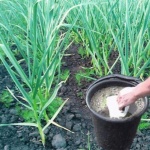
Top dressing of garlic plays a vital role in growing. The use of fertilizers contributes to the rapid growth of heads, an improvement in taste, and an increase in yield. There are many ways to feed him: this can be done with mineral or organic substances, as well as with all kinds of folk remedies.
Required climatic conditions
Garlic is winter-hardy, not afraid of frost, withstands short-term drought well. Plants are sensitive only to excessive moisture, they can rot in the soil in regions with a lot of rainfall.
Disease and pest resistance
The variety is highly immune to bacterial rot. Perfectly protected from a complex of diseases, rarely attacked by pests. Poorly dried garlic can be damaged by white rot or green mold after harvest. The affected heads are sorted, disposed of without leaving for storage.
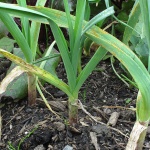
Review overview
Among the obvious advantages noted in the Komsomolets garlic is a very high cold resistance, which makes it suitable for cultivation in Siberia with pre-winter planting. Mention is also made of the abundant harvests harvested from the beds. But the variety is sensitive to the conditions created for it, needs a fertile layer in the root zone, does not like too intensive watering.
Komsomolets is also praised for the impressive size of the heads. Record indicators are obtained by summer residents who do not thicken the plantings. And also, many vegetable growers mention that the variety practically does not require special care or spraying, which allows you to grow an environmentally friendly product without nitrates and pesticides.
The obvious disadvantages of summer residents include a noticeable decrease in the size of the head on poor soils, the need to regularly change the landing site. For two years in a row, garlic does not grow on the same land. In addition, Komsomolets is prone to shooting. However, many summer residents turn this factor in their favor, pickling additional shoots as a savory snack along with other vegetables.
